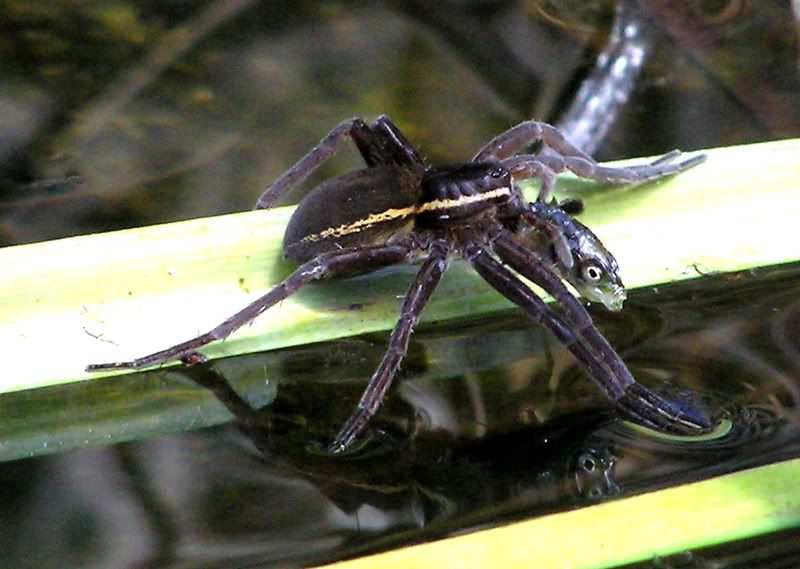 |
| Image by Helen Smith. Yeah, I think it’s pretty too. But look how surprised that fish is! |
These spiders are found throughout in wetlands throughout Europe, with a fairly spotty distribution. They do not build webs to hunt, preferring to wait on a stem with their front legs touching the water’s surface. When they feel a vibration, BAM! Dinner is served. Main courses typically include aquatic insects, water striders, and less frequently, fish, like our surprised friend shown above.
The water also comes in handy when a male Fen Raft Spider wants to woo the ladies. Courtship involves drumming the water until the couple meets, when they both begin to bob slowly to each other. Mating is quick, likely because it is not unheard of for the male to become a protein source. After laying the eggs, the female carries the egg sac under her fangs for about three weeks. After hatching, the young spend a week growing up in a web-nest that’s constructed and guarded by mom.
It seems that wetlands are disappearing everywhere, and therefore, so are the Fen Raft Spiders. The remaining wetlands are getting more and more pollution problems, and all evidence suggests that these spiders require clean water. There’s certainly hope though. Britain has pulled out all the stops trying to protect their two populations from dying out, and frankly, it seems to be working.
1Here’s a challenge for you readers: can somebody find me an endangered whipscorpion? That would be cool.
2These are not spiders.

6 comments:
You have confused me with your double asterisk! What is the antecedent to "These" in the phrase "These are not spiders."?
There is no such thing as an aquatic spider. The animals I linked to are called "Sea Spiders" but are more formally known as Pycnogonids. They are arachnids, but not spiders.
First off...these things freak me out ((shudders)) but here is a species listed as "sensitive" by the BLM in California:
Shoshone Cave whip-scorpion
Trithyreus shoshonensis
Here is the link to their list (it is on the very last page):
http://www.blm.gov/ca/pdfs/pa_pdfs/biology_pdfs/SensitiveAnimals.pdf
Oh my god, it's so incredibly ugly I could cry.
But I want to own one.
This is Kat, btw. :D I'm starting from here and will probably comment on others as I read backwards through the entries I still haven't read.
I watched quite surprised as a Fen Raft spider dined on a 10mm long fish in my pond today. It's the first time I have observed this behaviour from spiders. I'm in Port Vila, Vanuatu
What about the diving bell spider? http://en.wikipedia.org/wiki/Diving_bell_spider
Post a Comment